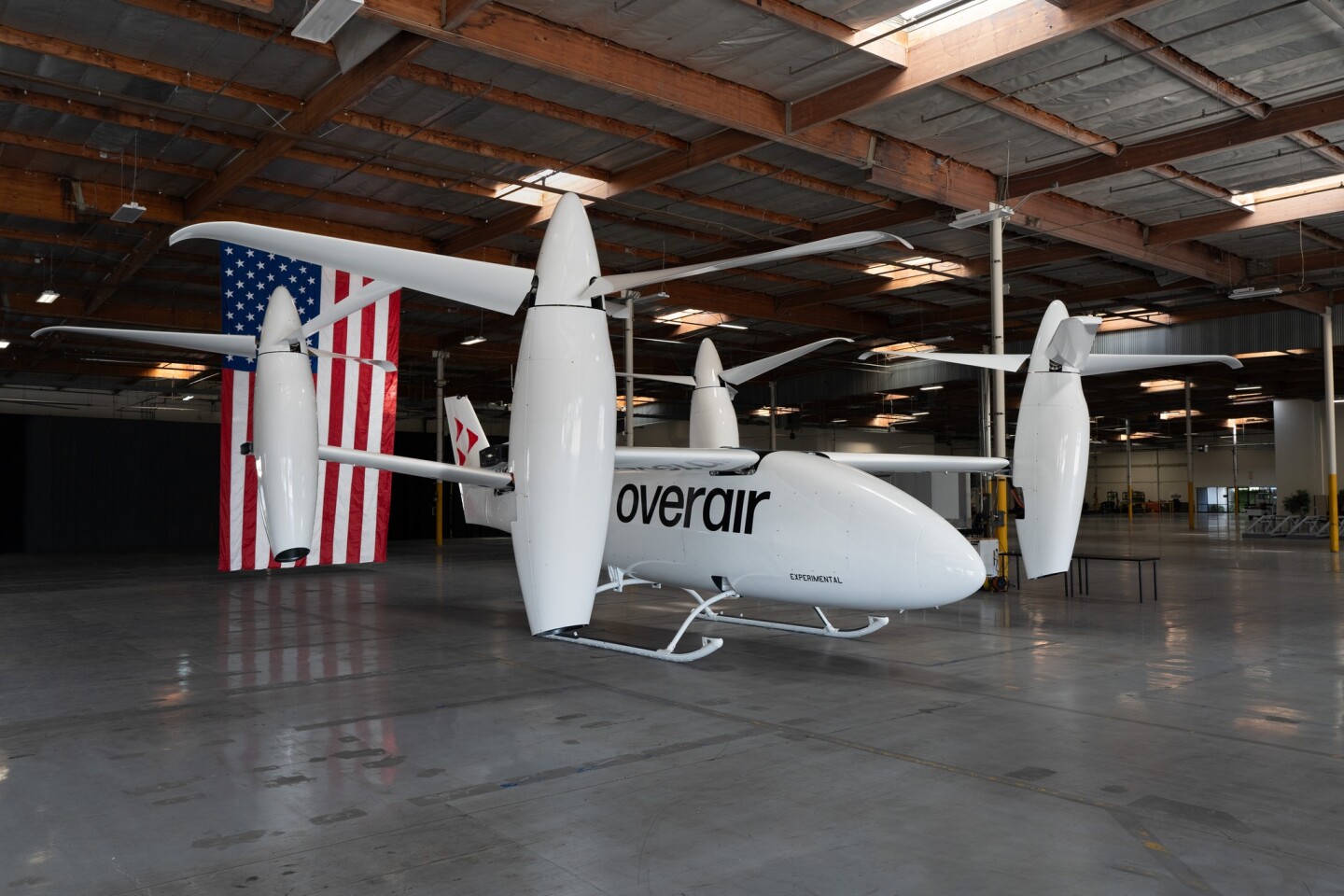Full-scale Overair Butterfly eVTOL prototype is set for first test flights
eVTOLs are one of those things that many groups announce their plans to create, but fail to produce in actual physical form. Such is not the case with Overair’s Butterfly however, the just-unveiled prototype of which should soon begin flight testing.
To recap our previous coverage, the Butterfly is an eVTOL (electric vertical take-off and landing) aircraft being developed by Overair, a California-based aeronautical startup. Overair’s parent company, Karem Aircraft, has been involved in a number of vertical-lift-related US military projects since it was founded in 2004.
Plans call for the commercial version of the Butterfly to carry one pilot and four passengers, be capable of a top speed of 200 mph (322 km/h), and have a battery range of up to 100 miles (161 km).
Propulsion is provided by four 3-bladed rotors – two on the wings and two on the V-tail – which tilt from a horizontal to vertical orientation when transitioning from vertical to forward flight.
One of the main things that sets the Butterfly apart from other eVTOLs is the large size of those rotors, each of which is over 20 ft (6 m) wide. These should produce more thrust per kilowatt of power than other designs with smaller rotors.
What’s more, the rotor RPMs (revolutions per minute) and individual blade angles are continuously and automatically adjusted. Tweaking the RPMs should reportedly boost efficiency across all flight modes – potentially reducing power demand when hovering by 60% – while adjusting the blade angles should reduce vibrations and propeller loads, enhance safety, provide a smoother ride quality, and reduce maintenance costs.
Overair
Announced this Tuesday (Dec. 19th) the full-scale prototype incorporates the technologies described above, although it’s an uncrewed remote-control stand-in for the production model. Ground-based testing is already underway at Overair’s headquarters in Santa Ana, California.
Flight testing should begin early next year, at the company’s test facility in the nearby city of Victorville. The initial tests will focus on validating the propulsion systems, flight control mechanics, safety features and operational efficiency, along with the aircraft’s 55-decibel noise target.
“Assembling our first full-scale prototype vehicle marks the culmination of years of industry expertise, meticulous development planning, innovative engineering, and the hard work of the entire Overair team,” said CEO Ben Tigner. “This seamless transition from propulsion testing to a full-scale prototype underscores our dedication to redefining the eVTOL landscape with safer, quieter, and more reliable aircraft.”
Source: Overair
eVTOLs are one of those things that many groups announce their plans to create, but fail to produce in actual physical form. Such is not the case with Overair’s Butterfly however, the just-unveiled prototype of which should soon begin flight testing.
To recap our previous coverage, the Butterfly is an eVTOL (electric vertical take-off and landing) aircraft being developed by Overair, a California-based aeronautical startup. Overair’s parent company, Karem Aircraft, has been involved in a number of vertical-lift-related US military projects since it was founded in 2004.
Plans call for the commercial version of the Butterfly to carry one pilot and four passengers, be capable of a top speed of 200 mph (322 km/h), and have a battery range of up to 100 miles (161 km).
Propulsion is provided by four 3-bladed rotors – two on the wings and two on the V-tail – which tilt from a horizontal to vertical orientation when transitioning from vertical to forward flight.
One of the main things that sets the Butterfly apart from other eVTOLs is the large size of those rotors, each of which is over 20 ft (6 m) wide. These should produce more thrust per kilowatt of power than other designs with smaller rotors.
What’s more, the rotor RPMs (revolutions per minute) and individual blade angles are continuously and automatically adjusted. Tweaking the RPMs should reportedly boost efficiency across all flight modes – potentially reducing power demand when hovering by 60% – while adjusting the blade angles should reduce vibrations and propeller loads, enhance safety, provide a smoother ride quality, and reduce maintenance costs.

Overair
Announced this Tuesday (Dec. 19th) the full-scale prototype incorporates the technologies described above, although it’s an uncrewed remote-control stand-in for the production model. Ground-based testing is already underway at Overair’s headquarters in Santa Ana, California.
Flight testing should begin early next year, at the company’s test facility in the nearby city of Victorville. The initial tests will focus on validating the propulsion systems, flight control mechanics, safety features and operational efficiency, along with the aircraft’s 55-decibel noise target.
“Assembling our first full-scale prototype vehicle marks the culmination of years of industry expertise, meticulous development planning, innovative engineering, and the hard work of the entire Overair team,” said CEO Ben Tigner. “This seamless transition from propulsion testing to a full-scale prototype underscores our dedication to redefining the eVTOL landscape with safer, quieter, and more reliable aircraft.”
Source: Overair
